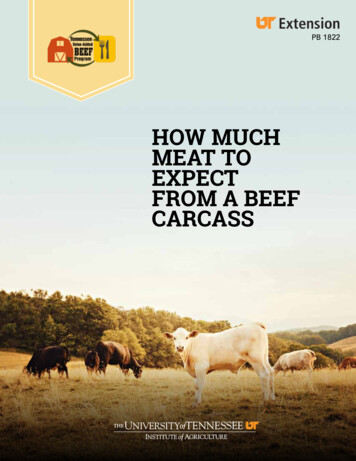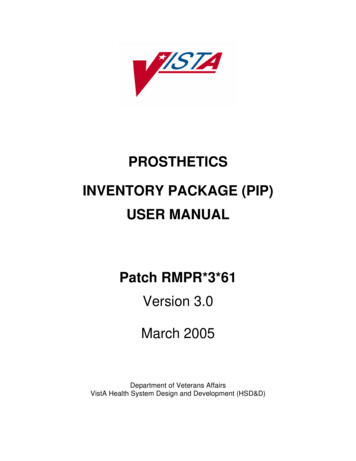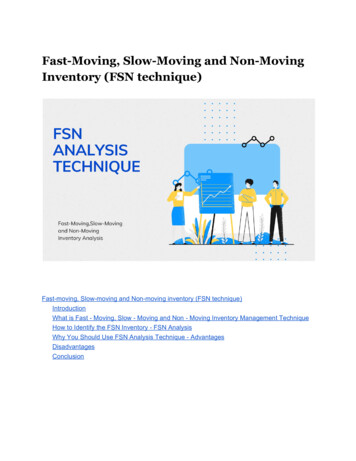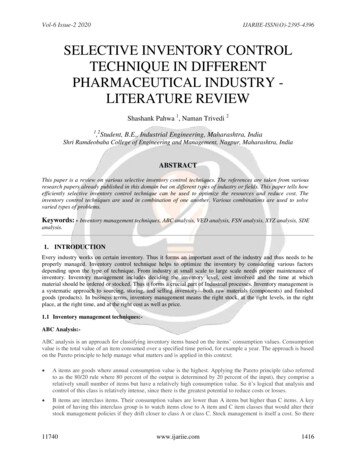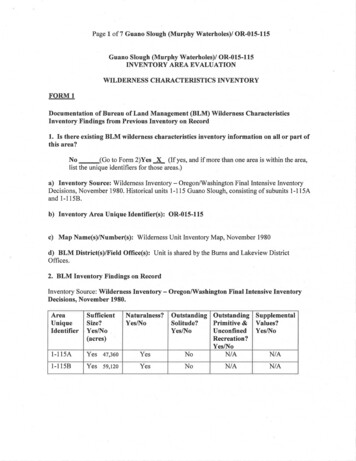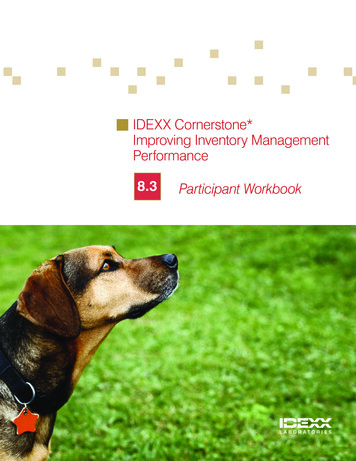
Transcription
MEAT MARKETING SERIES:INVENTORY MANAGEMENTTHROUGH BUFFERSFEBRUARY 2017
MEAT MARKETING SERIES:INVENTORY MANAGEMENTTHROUGH BUFFERSCONTENTSIntroduction . . . . . . . . . . . . . . . . . . . . . . . . . . . . . . . . . . . . . . . . . . . . . . . . . . . . . . . . . . . . . . . . . . . . . . . . . . . . . . . . . . . . . . . . . . . . . . . . . . . . 3The Need . . . . . . . . . . . . . . . . . . . . . . . . . . . . . . . . . . . . . . . . . . . . . . . . . . . . . . . . . . . . . . . . . . . . . . . . . . . . . . . . . . . . . . . . . . . . . . . . . . . . 4Planning for a World That We Don't Understand . . . . . . . . . . . . . . . . . . . . . . . . . . . . . . . . . . . . . . . . . . . . . . . . . . . . . . . . . . 4Buffers: No Clairvoyance, No Problem . . . . . . . . . . . . . . . . . . . . . . . . . . . . . . . . . . . . . . . . . . . . . . . . . . . . . . . . . . . . . . . . . . . . . . . . . . . . . . 5The Step-by-Step Buffering Method . . . . . . . . . . . . . . . . . . . . . . . . . . . . . . . . . . . . . . . . . . . . . . . . . . . . . . . . . . . . . . . . . . . . . . . . . . . . . . . . . 5Jane the Meat Marketer: Putting Carcass Management into Practice . . . . . . . . . . . . . . . . . . . . . . . 6Jane the Meat Marketer: Replenishment . . . . . . . . . . . . . . . . . . . . . . . . . . . . . . . . . . . . . . . . . . . . . . . . . . . . . . . . . . . . . . . . . . . . . . . . . . 7Replenishment: The Relationships Between Cash Flow,Inventory and Lead Time . . . . . . . . . . . . . . . . . . . . . . . . . . . . . . . . . . . . . . . . . . . . . . . . . . . . . . . . . . . . . . . . . . . . . . . . . . . . . . . . . . . . . . . . . . . . . . . . . . . 8Conclusions. . . . . . . . . . . . . . . . . . . . . . . . . . . . . . . . . . . . . . . . . . . . . . . . . . . . . . . . . . . . . . . . . . . . . . . . . . . . . . . . . . . . . . . . . . . . . . . . . . .AuthorsAcknowledgementsNick McCann,Good Food Fund Value Chain Specialist,MSU Center for Regional Food Systems (CRFS)The authors would like to thankDr. Lauren Gwin and Kathryn Quanbeckfor their thorough reviews of this reportand their valuable feedback.8Noel Bielaczyc,Value Chain Specialist,MSU Center for Regional Food Systems (CRFS)MSU CENTER FOR REGIONAL FOOD SYSTEMS // MEAT MARKETING SERIES: SELLING THE WHOLE ANIMAL2
MEAT MARKETING SERIES:INVENTORY MANAGEMENTTHROUGH BUFFERSINTRODUCTIONInventory managementis a key factor in buildingany meat business.Inventory management is a key factor in buildingany meat business. As explained in a previousmeat publication,1 the key prerequisite for makingmoney marketing meat is having the right productavailable at the right time.2 We need to do thiswithout carrying more inventory than we need, asinventory ties up cash and can spoil. We also needto do this without knowing the precise demand ofeach product or SKU. As such, managing inventoryto maintain product availability for customers is akey part of wholesale meat marketing success.It is important to note that this inventory managementpublication is aimed at meat marketers who areinventorying meat for direct delivery to wholesalecustomers. For meat marketers who are usinglarger distribution networks in multiple regions,additional inventory management considerationsexist, even though the buffering principlesdescribed here are the same or similar. In-depthexamples and explanations for managing a largerdistribution network can be found in Chapter 4of Orlicky’s Material Requirements Planning.31 foodsystems.msu.edu/resources/meat marketing series selling the whole animaland managing variability2 This assumes that a market exists at the price you are charging.3 Ptak, C. A., Smith, C., & Orlicky, J. (2013;2011;). Orlicky's Material Requirements Planning(3rd ed.). New York: McGraw-Hill.MSU CENTER FOR REGIONAL FOOD SYSTEMS // MEAT MARKETING SERIES: SELLING THE WHOLE ANIMAL3
The NeedAny inventory management strategy must satisfythree key prerequisites to be successful.First, the strategy must always (or almost always)maintain product availability for the customer.When meat is not available, customers are notable to buy, and we face two consequences:(1) We miss out on potential sales and income.(2) We run the risk that our customers willlook elsewhere and find a better deal.Second, the strategy we use must minimize theamount of inventory that we carry. Carryingperishable inventory comes with two equallyimportant problems: (1) It ties up cash withproduct that you have paid for but haven’t yet sold.This lowers your business return on investmentand blocks growth. (2) There is a real risk thatyou could lose product to spoilage. The risk ofspoilage puts pressure on marketers to lowertheir prices to move product quickly. Lower priceshurt margins and force us to devote time andeffort (business capacity) to marketing effortson low-margin, soon-to-spoil products. This isoften an unmeasurable opportunity cost.Third, the strategy must be relatively simpleto implement, with very little in the way ofextra work or expensive software. Most of usrun small businesses, and as such, we don’t havecash lying around for a new computer systemand we are strapped for time and focus. Andmany businesses that do have expensive newinventory software find that, while the softwaresaves some time in management, we end upspending more time managing, fixing, or otherwisebootstrapping the software. With everythinga business has to manage, adding anothertask (even a small one) can be a problem.Planning for a World That We Don’t UnderstandExisting inventory management methodologiesinvolve varying degrees of complexity. Most of thesemethodologies require predictions of future demandand focus on minimizing shipping costs. Whenwe work from a paradigm of forecasting and costminimization, the results can often be less than stellar.Even if we can employ these sophisticatedtechnologies, we often find that the marginalreturn for our time, focus, and money is lessthan appealing. The truth is that even the mostcomplicated predictive methodologies give onlyguesses. The more you spend, the more educatedyour guesses become, but they are still guesses.While sophisticated forecasting technologiesexist, the cost to access such programs is oftenprohibitive in terms of actual cash outlay and theperson-hours required to implement the programs.MSU CENTER FOR REGIONAL FOOD SYSTEMS // MEAT MARKETING SERIES: INVENTORY MANAGEMENT THROUGH BUFFERS4
Buffers: No Clairvoyance, No ProblemIf the truth is that the task of predicting thefuture ranges from difficult to impossible, thenour behavior should reflect the fact that we don’tunderstand exactly what future demand for ourmeat products will be. Successful small meatmarketers manage buffers, not forecasts. A bufferis an inventory position that will last long enoughto take a replenishment from your meat plant withsome safety stock besides. Vendors make mistakesor are slow, customers can be fickle, trucks breakdown what can go wrong will go wrong, often atthe worst possible time. The buffer is designed toinsulate your business from the inherent variabilityof the outside world. If each unpredictable event orchange in demand sends your business into chaos,the result can be more stress, higher costs, andfewer customers. Buffers help us anticipate a rangeof alternate futures and put inventory in the rightplace so that customers will get what they wantwhen they want it—and we can preserve our sanity.The Step-by-Step Buffering MethodGo through this process for each of your product SKUs. (See "Putting CarcassManagement Into Practice," on page 6 for an example.)1. Set the Buffer Size. This is an easy calculation:BUFFER SIZE (Average Demand per Demand Period4 Transportation Lead Time5 Production Lead Time6 Order Lead time Safety Stock7)2. Replenish the Buffer. In buffer management, we focus on replenishing thebuffer. The easiest way to do this is to simply use your sales numbers as a proxyfor reorder and set a time each week to replenish the inventory.3. Manage the Buffer. Over time, demand can change. Because of this, it is important for us to periodicallyrevisit inventories to make sure that we are not holding too much or too little. A simple method formanaging our inventory is the red/yellow/green method. Basically, we divide the buffer into thirds.When inventory is in the top third, it is in the green zone. When inventory is in the middle third, it is inthe yellow zone, and in the bottom third, the red zone. If products are consistently entering the redzone in each replenishment period, this is a signal to meat marketers that demand has increased andwe need to do another buffer calculation. The same is true if inventory stays in the green zone toooften: Demand has probably changed, and we need to consider decreasing the inventory level.4 The demand period is the time between stock replenishments. It could be daily, weekly, monthly, or yearly. See the replenishment section for recommended replenishment frequency.5 This is the lead time between the day a product is ready to ship and the day of its actual delivery to your dock.6 This is the lead time between the day you deliver animals to a plant and the day that product is ready to go.7 This calculation is a modification of material presented by Dr. K.J. Youngman, available here: dbrmfg.co.nzMSU CENTER FOR REGIONAL FOOD SYSTEMS // MEAT MARKETING SERIES: INVENTORY MANAGEMENT THROUGH BUFFERS5
JANE THE MEAT MARKETER:PUTTING CARCASS MANAGEMENT INTO PRACTICE1. Jane Sets the Buffer SizeJane sells meat to various retail and wholesale buyersin her region. She has a central facility where shestores her meat products. The goal of Jane’s inventorymanagement strategy is to maintain availability for hercustomers without holding so much stock that she isafraid of spoilage or has cash flow problems. Jane wantsto take the emotion out of her decisions, and as such,she wants an easy, scientific inventory managementmethodology that she can implement without toomany headaches. She heard about the bufferingmethod and decided to try it for a few of her SKUs.She starts with frozen Italian sausage and a demandperiod of 1 week. Jane knows that she sells about1,000 pounds per week on average. When she putsin an order, it takes her meat plant 1 week to producethe product, and shipping from the plant to her coldstorage facility takes 3 days. Jane usually likes to waitup to 2 weeks to save herself money on shipping—she gets 25% off when she ships 2 pallets at a time(1,000 lbs. per pallet). Jane’s plant also gives her anextra 5% off processing if she orders a minimum of2,000 lbs. Overall, Jane saves up for a big batch andproduces frozen Italian sausage once every 2 weeks.Average Demandper Demand Period1,000 lbs./week(143 lbs./day)3 days(450 lbs.) ProductionLead Time1 week(1,000 lbs.) OrderLead Time2 weeks(2,000 lbs.) 1,000 lbs. TransportationLead TimeSafetyStockBuffer Size5,450 lbs.So, Jane’s average demand is 1,000 lbs., the productionlead time is 1 week (1,000 lbs.), her order lead timeis 2 weeks (2,000 lbs.), and her transportation leadtime is 3 days (450 lbs.). She knows that every nowand then, the truck breaks down or the plant is lateon shipment, so she will need an extra 1,000 lbs.of product in case there is a delay. Overall, Jane’sbuffer size for frozen Italian sausage is 5,450 lbs.Jane's Buffer Size Calculation1,000 lbs./week (translates to 143 lbs./day). Average Demand per Demand Period3 days (translates to 450 lbs.). Transportation Lead Time1 week (translates to 1,000 lbs.). Production Lead Time2 weeks (translates to 2,000 lbs.). . . Order Lead Time 1,000 lbs. Safety Stock5,450 lbs. Buffer SizeMSU CENTER FOR REGIONAL FOOD SYSTEMS // MEAT MARKETING SERIES: SELLING THE WHOLE ANIMAL6
JANE THE MEAT MARKETER:PUTTING CARCASS MANAGEMENT INTO PRACTICE (continued)2. Jane Replenishes the Buffer3. Jane Manages the BufferJane orders frozen Italian sausage once everytwo weeks. She has learned that buffering inventorymanagement methodologies require her to order notwhen inventory gets low but on the same day everytwo weeks. She is practicing a method called fixed-timevariable-reorder quantity. In practice, Jane uses hersales numbers as a proxy for reorder, simply orderingthe amount she has sold in the most recent demandperiod. When she sells 2,000 lbs., she orders 2,000 lbs.When she sells 1,500 lbs., she orders 1,500 lbs. The resultis an easy purchasing decision that, combined withthe buffer, minimizes Jane’s inventory while servingher customers what they need when they need it.Jane is very busy. Between sales, customer service,employee management, and financial management, shedoesn’t have much time to get bogged down lookingat spreadsheets or doing calculations. As such, sheuses the red/yellow/green method to help focus herattention only on the SKUs that are running too muchor too little inventory. Now, Jane has a no-nonsenseway to make scientific decisions on her inventoryand focus her attention only on the SKUs that requireadditional management analysis. She saves time andcan devote her attention to other business problems,secure in the knowledge that she is paying attention tothe important issues in her inventory management.Inventory consistently in thegreen shows decreased demand,reduce the buffer.Inventory consistently in thered shows increased demand,increase the buffer.MSU CENTER FOR REGIONAL FOOD SYSTEMS // MEAT MARKETING SERIES: SELLING THE WHOLE ANIMAL7
JANE THE MEAT MARKETER:REPLENISHMENTJane is reordering frozen Italian sausage once every twoweeks. She saves a considerable amount of money onshipping, and the plant gives her a break on a larger batch.The savings are nice, but do they really help Jane’s businessoverall? She takes some time to think about her situationand starts to doubt the efficacy of her savings. First,shipping costs for her product are a small percentage ofthe overall cost involved in getting the product to market. Ifshe pays 3.49 per pound for pasture-raised pork trim andanother 0.79 per pound for processing, her total bill for1,000 lbs. could be more than 4,000. Did getting 25% offa 200 truck expense really help her? The same questioncan be asked of Jane’s processing savings. Is 5% off for20% of the expense of bringing pastured pork to marketreally the best way to improve business profitability?Jane does some thinking and realizes that she mightbe able to reduce the cash needs of her business byone-third or one-half if she reduces her lead timeand processes product every week. See Figure 1 fora comparison of 1-week vs. 2-week lead time.Jane is amazed by the amount of cash she is able tofree up from her system without reducing her product’savailability to customers. The cash savings came at a goodtime because Jane just got her first order from a largecustomer that pays slowly. This will ensure that she canopen the new account with relatively few headaches andwithout going to the bank for a new operating loan.FIG. 1: Inventory Graph of 2-Week vs. 1-Week Order Lead TimeAMOUNT OF PRODUCT IN STOCK2-Week Lead Time1-Week Lead TimeStockSurplusReorder PointDaily DemandStock ShortageTIMEMSU CENTER FOR REGIONAL FOOD SYSTEMS // MEAT MARKETING SERIES: INVENTORY MANAGEMENT THROUGH BUFFERS8
Replenishment: The Relationships BetweenCash Flow, Inventory, and Lead TimeAs shown in the previous section, Jane the meatmarketer is a cost-conscious business manager.Whenever she has a chance to lower her costs, shetakes it. Cost-conscious behavior is a good thingwhen it comes to managing a business. However,when it increases lead time for replenishment of yourstock, reducing costs can be counterproductive.When operating any distribution business (orcomponent of a business), it is important torecognize that cash on hand is often a constraint onbusiness growth or, at very least, a major factor inreturn on investment for the distribution component.8ConclusionsFor marketers interested in selling local meat,managing inventory is one of the most importantaspects of their business. Too much inventoryand we tie up cash in perishable inventory. Toolittle inventory and we risk missing out on salesand disappointing customers. Buffering inventory,as highlighted above, is a simple way for smallbusinesses to make inventory decisions thatcan lead to increased revenue, better returnon investment, and lower operating costs.8 store.extension.iastate.edu/Product/lf5-pdfMSU CENTER FOR REGIONAL FOOD SYSTEMS // MEAT MARKETING SERIES: SELLING THE WHOLE ANIMAL9
CRFS envisions a thriving economy, equity, and sustainability for Michigan, the country, and the planet through foodsystems rooted in local regions and centered on Good Food: food that is healthy, green, fair, and affordable. Its missionis to engage the people of Michigan, the United States, and the world in applied research, education, and outreach todevelop regionally integrated, sustainable food systems. CRFS joins in Michigan State University’s pioneering legacyof applied research, education, and outreach by catalyzing collaboration and fostering innovation among the diverserange of people, processes, and places involved in regional food systems. Working in local, state, national, and globalspheres, CRFS’ projects span from farm to fork, including production, processing, distribution, policy, and access.Center for Regional Food SystemsMichigan State University480 Wilson RoadNatural Resources BuildingEast Lansing, MI, 48824For general inquiries:LEARN: foodsystems.msu.eduEMAIL: CRFS@anr.msu.eduCALL: 517-353-3535FOLLOW: @MSUCRFSEmail addresses and phone numbers forindividual staff members can be foundon the people page of our website.
without carrying more inventory than we need, as inventory ties up cash and can spoil. We also need to do this without knowing the precise demand of each product or SKU. As such, managing inventory to maintain product availability for customers is a key part of wholesale meat marketing success. It is important to note that this inventory management


